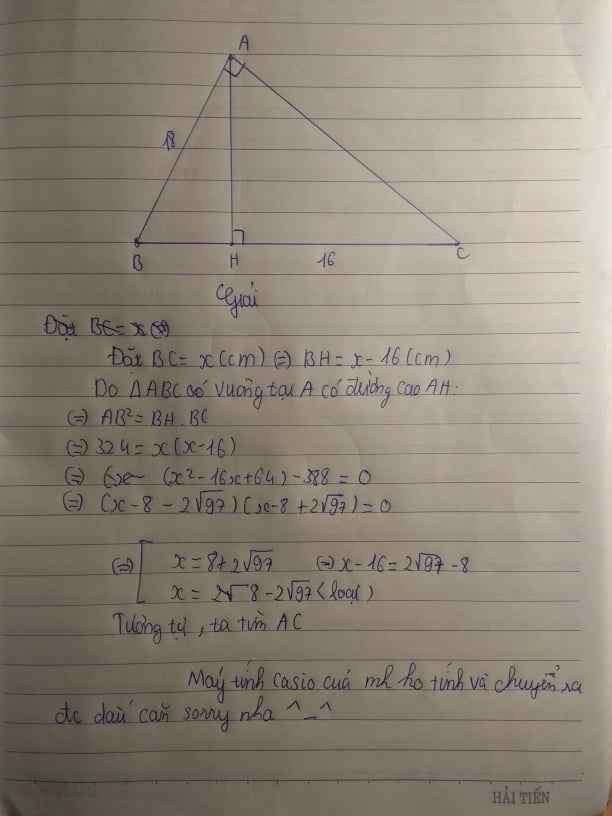
Hãy nhập câu hỏi của bạn vào đây, nếu là tài khoản VIP, bạn sẽ được ưu tiên trả lời.


Bài 3:
a: Ta có: \(x-2\sqrt{x+8}=0\)
\(\Leftrightarrow\sqrt{4x+32}=x\)
\(\Leftrightarrow4x+32=x^2\)
\(\Leftrightarrow x^2-4x-32=0\)
\(\Leftrightarrow\left(x-8\right)\left(x+4\right)=0\)
\(\Leftrightarrow\left[{}\begin{matrix}x=8\left(nhận\right)\\x=-4\left(loại\right)\end{matrix}\right.\)
b: Ta có: \(3\sqrt{x+5}=4x-7\)
\(\Leftrightarrow\left(4x-7\right)^2=9x+45\)
\(\Leftrightarrow16x^2-56x+49-9x-45=0\)
\(\Leftrightarrow16x^2-65x+4=0\)
\(\Leftrightarrow16x^2-64x-x+4=0\)
\(\Leftrightarrow\left(x-4\right)\left(16x-1\right)=0\)
\(\Leftrightarrow\left[{}\begin{matrix}x=4\\x=\dfrac{1}{16}\end{matrix}\right.\)


Sửa đề: BD=7,5cm
BC=7,5+10=17,5cm
AD là phân giác
=>AB/BD=aC/CD
=>AB/3=AC/4=k
=>AB=3k; AC=4k
AB^2+AC^2=BC^2
=>25k^2=17,5^2
=>k=3,5
=>AB=10,5cm; AC=14cm
AH=10,5*14/17,5=8,4cm
\(AD=\dfrac{2\cdot AB\cdot AC}{AB+AC}\cdot cos45=\dfrac{2\cdot10.5\cdot14}{10.5+14}\cdot\dfrac{\sqrt{2}}{2}=6\sqrt{2}\left(cm\right)\)


Gọi độ dài đoạn BH là: \(x\) ( cm) ; \(x\) > 0; AC > AB nên \(x\) < CH
Xét tam giác vuông HAB vuông tại H theo pytago ta có:
AB2 = HA2 + HB2 = 9,62 + \(x^2\) = 92,16 + \(x^2\)
Xét tam giác vuông AHC vuông tại H theo pytago ta có:
AC2 = HA2 + HC2 = 9,62 + (\(20-x\))2 = 92,16 + 400 - 40\(x\) + \(x^2\)
AC2 = 492,16 - 40\(x\) + \(x^2\)
Xét tam giác vuông ABC vuông tại A theo pytago ta có:
AC2 + AB2 = BC2
492,16 - 40\(x\) + \(x^2\) + 92,16 + \(x^2\) = 202
(\(x^2\) + \(x^2\)) - 40\(x\) + (492,16 + 92,16) - 400 = 0
2\(x^2\) - 40\(x\) + 584,32 - 400 = 0
2\(x^2\)- 40\(x\) + 184,32 =0
\(x^2\) - 20\(x\) + 92,16 = 0
△' = 102 - 92,16 = 7,84 > 0
\(x\)1 = -(-10) + \(\sqrt{7,84}\) = 12,8 ⇒ CH = 20 - 12,8 = 7,2 < BH (loại )
\(x_2\) = -(-10) - \(\sqrt{7,84}\) = 7,2 ⇒ CH = 20 - 7,2 = 12,8 (thỏa mãn)
Thay \(x_2\) = 7,2 vào biểu thức: AB2 = 92,16 + \(x^2\) = 92,16 + 7,22 = 144
⇒AB = \(\sqrt{144}\) = 12
Thay \(x_2\) = 7,2 vào biểu thức: AC2 = 492,16 - 40\(x\) + \(x^2\)
AC2 = 492,16 - 40\(\times\) 7,2 + 7,22 = 256
AC = \(\sqrt{256}\) = 16
Kết luận AB = 12 cm; AC = 16 cm

1.
\(P=\dfrac{3}{\sqrt{x}+3}\le\dfrac{3}{0+3}=1\)
\(\Rightarrow maxP=1\Leftrightarrow x=0\)
2.
\(A=\dfrac{2\sqrt{x}-1}{\sqrt{x}+1}=\dfrac{2\left(\sqrt{x}+1\right)-3}{\sqrt{x}+1}=2-\dfrac{3}{\sqrt{x}+1}\ge2-\dfrac{3}{0+1}=-1\)
\(\Rightarrow minA=-1\Leftrightarrow x=0\)





4.
\(P=\dfrac{\sqrt{x}-1}{\sqrt{x}+1}=\dfrac{\sqrt{x}+1-2}{\sqrt{x}+1}=1-\dfrac{2}{\sqrt{x}+1}\ge1-\dfrac{2}{0+1}=-1\)
\(\Rightarrow minP=-1\Leftrightarrow x=0\)
5.
a, \(P=\dfrac{\sqrt{x}-1}{\sqrt{x}+2}=\dfrac{\sqrt{x}+2-3}{\sqrt{x}+2}=1-\dfrac{3}{\sqrt{x}+2}\ge1-\dfrac{3}{0+2}=-\dfrac{1}{2}\)
\(\Rightarrow minP=-\dfrac{1}{2}\Leftrightarrow x=0\)
b, ĐK: \(x\ne1\)
\(\dfrac{5}{\sqrt{x}-1}.P=\dfrac{5}{\sqrt{x}-1}.\dfrac{\sqrt{x}-1}{\sqrt{x}+2}=\dfrac{5}{\sqrt{x}+2}\le\dfrac{5}{0+2}=\dfrac{5}{2}\)
\(\Rightarrow max=\dfrac{5}{2}\Leftrightarrow x=0\)